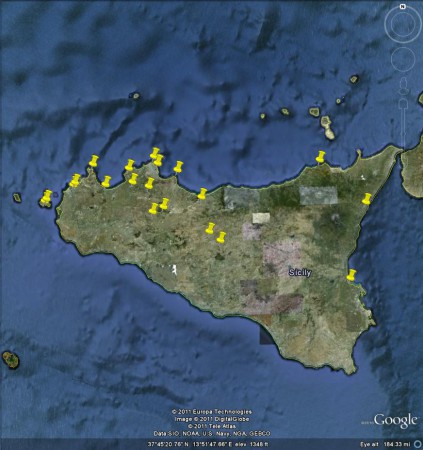- A large-scale intervention to introduce orange sweet potato in rural Mozambique increases vitamin A intakes among children and women. Just 1 year of training worked just as well as a higher intensity intervention (3 years) in increasing OSP and vitamin A intake by younger children, older children and women, and decreasing prevalence of inadequate vitamin A intakes. OSP represented about half of all sweet potatoes consumed so I guess there was not complete replacement of local varieties.
- Composition of milk from minor dairy animals and buffalo breeds: a biodiversity perspective. There are significant interbreed and inter-species differences. Dromedary milk is closest to cow milk, mare and donkey milk maybe the healthiest, but moose milk is the one I’d like to try.
- Quality indicators for passport data in ex situ genebanks. That would be the genebanks in Eurisco. Verdict: not bad, but could do better. Most variation in quality is among institutes.
- Exploring the population genetics of genebank and historical landrace varieties. Old samples of dead seeds of 4 crops in Swedish museum jars more genetically variable than genebank accessions, but it’s not the genebank’s fault. And at least their seeds are still alive. Also no genetic correspondence between geographically matched museum and genebank samples.
- Combining chloroplast and nuclear microsatellites to investigate origin and dispersal of New World sweet potato landraces. Two areas of domestication, probably from a single wild progenitor species: lowland NW South America and lowland Central America/Caribbean. Genetic differences between these 2 genepools not accompanied by morphological differences, but then again nobody’s looked properly, and the current descriptors are useless anyway.
- The significance of African vegetables in ensuring food security for South Africa’s rural poor. Their huge potential is being thwarted by evil extensionists. Ok, but don’t we need to move beyond that?
- Comparative study on baobab fruit morphological variation between western and south-eastern Africa: opportunities for domestication. Hang on a minute, aren’t there a million factsheets about all this?
- Marriage exchanges, seed exchanges, and the dynamics of manioc diversity. Kinship structures determine cassava diversity patterns in Gabon. Matrilineal societies have more diversity.
- Interspecific hybridization of diploids and octoploids in strawberry. You get pentaploid and tetraploid plants.
- Genome wide association analyses for drought tolerance related traits in barley (Hordeum vulgare L.). Ok, deep breath. Over 200 accessions, both wild and cultivated, from 30 countries, so quite variable, but also structured. There were some QTLs that differed between dry and wet sites, but they didn’t explain much phenotypic variation, and they couldn’t be related to previous work. So GWA not much use, probably because of population structure. But couldn’t that have been predicted? And isn’t it possible to do something about structure in the analysis?
- Population genetics of beneficial heritable symbionts. Of insects, that is. Mostly proteobacteria. So my question is, could somehow attacking the symbionts form the basis of a pest management strategy?
- Projecting the effects of climate change on the distribution of maize races and their wild relatives in Mexico. Many races and wild relatives are predicted to shift in geographic distribution. Unless of course agronomy intervenes. Teocinte taxa should be collected.
Nibbles: Q&A, Zoopharmacognosy, Pigeonpea genome, Turkey, Wheat relatives
- Everyday agriculture mysteries solved.
- Other animals self-medicate too.
- Dueling pigeonpea genome sequencers? Who knew. Well spotted, James.
- I’m thankful for turkeys.
- And for the crop wild relatives in ICARDA’s genebank too.
Pizzutello: An ampelographer writes
Our discussion of Ruoppolo’s grapes found its way to Erika Maul, curator of the German grape collection and manager of the European Vitis database. 1 Many thanks to Helmut Knuepffer for facilitating that process and for providing this translation of Erika’s comments.
About 20 years ago I tried the to solve the confusion concerning Pizzutello, Cornichon Blanc, Dedo de Dama, Kadin Barmak, Lady’s Finger Grape, etc. from behind my writing desk. Since this turned out to be impossible, I then introduced grape varieties from different germplasm collections, to get the thing on track. For various reasons, I did not succeed and since then I did not take up the matter again.
However, what appears certain to me is that these grape forms had quite some importance as a curiosity, due to the particular shape of their fruits. (That shape evolves when the seeds do not develop. The well-shaped outer part includes a seed, while in the inner shorter compartment the seed is only rudimentary.) Presumably these forms come from the Near East, and they do not ripen in our northern growing areas — even in warmer summers.
That will make a nice project for someone some day…
Nibbles: Taiwan seedbank, American agroforestry
- Taiwan should establish a national seed bank. It says here. But will it be a genebank?
- Agroforestry in the USA and in the ancient Maya lands.
“Super broccoli” from field to fork
The story begins in the Mediterranean in the early 1980s when Professor Richard Mithen, currently at IFR, was on a field trip to collect rare plants as part of his PhD at the University of East Anglia. “We collected wild brassicas in southern Italy and Sicily, and that material was sent into various seed banks in Italy, Sweden and Spain,” says Mithen. “I was able to go on this expedition due to Professor Harold Woolhouse, the then Director of the John Innes Institute, who provided me with a small grant to cover some of my travel costs.”
If you want to read about this collecting trip, you can, thanks to the Collecting Missions Repository: look for CN375. Here’s the material the boys collected which ended up in Spain, according to an “advanced” Eurisco search, as mapped by Genesys:

Where does the story end, you ask? Well, with Beneforté ‘super broccoli’. And a fascinating story it is too. Read for yourself.
LATER: Prof. Mithen informs me the wild species involved was Brassica villosa.